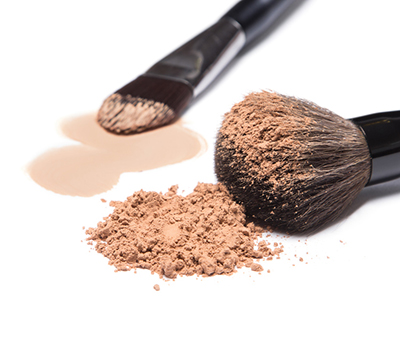 The sensorial modifier is one of the main success factors in a skin care emulsion. Many kinds of modifiers are available, such as silicones, esters, hydrocarbons, and ethoxylated glycerol esters. However, I would like to focus on raw materials that provide dry touch and a velvety sensorial effect. Among this class of raw materials are modified starches, silicas, nylon-12, polymethyl methacrylates and the new glass spheres.
The sensorial modifier is one of the main success factors in a skin care emulsion. Many kinds of modifiers are available, such as silicones, esters, hydrocarbons, and ethoxylated glycerol esters. However, I would like to focus on raw materials that provide dry touch and a velvety sensorial effect. Among this class of raw materials are modified starches, silicas, nylon-12, polymethyl methacrylates and the new glass spheres.
We can group these raw materials into those that provide a “desiccated” dry effect and those that provide a “velvety” dry effect. Both have the ability to adsorb oleosity originating either from the skin or from the product itself, such as photo-protection products.
Looking for sensory modifiers for your skin care product?
Prospector has listings for sensory modifiers, including data sheets and more.
Search Sensory Modifiers
Raw materials with a “desiccated” dry effect
Modified starches are part of this class of materials. Tapioca starch (Tapioca Pure) is a quite interesting option to use in moisturizers that require fast drying. The modified starch known as Dry Flo® (aluminum starch octenylsuccinate) is the cosmetics industry’s first option for a good reason: concentrations starting at 5% will already offer a remarkable dry effect.
I have used 12% in some formulations to obtain a product that provided up to 6 hours of oleosity control. Corn starch (Farmal CS 3650) offers the best cost; however, it provides an inferior effect when compared to tapioca and Dry Flo®. Talking about costs, this is the main advantage of these starches. They are much more affordable when compared to other raw materials that provide a “velvety” dry effect.
Raw materials with a “velvety” dry effect
Raw materials from this class offer a really sophisticated sensorial experience and also provide an effect known as “soft focus,” that acts as an optical diffuser, masking wrinkles and dilated pores. These raw materials are used in trendy blur formulations and have a higher cost in comparison to starches.
From this class, we can highlight Marshmallow Powder (HDI/Trimethylol Hexyllactone Crosspolymer (and) Polymethyl Methacrylate) that, as the name says, provides a padding effect similar to marshmallow. It also offers a remarkable effect when used in concentrations starting at only 2%. Silicas and nylon-12 have been used for a long time, especially in photo-protection formulations, to remove the oily effect from the product. 3M innovated by releasing a raw material based on glass spheres called Glass Bubble. The main advantage of this raw material is the “ball bearing” effect that, beyond the benefits already pointed out, helps to improve the product’s spreading.
Formulating with sensorial modifiers
Considering that we have available raw materials with lower cost that will not provide a velvety effect, and high-cost raw materials with a sophisticated effect, we simply have to associate both classes in order to obtain a cost-effective system with high performance of dry and velvety sensorial effect. For example, a successful association that I frequently use is to add 7-10% of modified starch associated with 2-3% of Marshmallow Powder. I use a higher concentration of lower cost raw material and no more than 3% of more sophisticated raw materials
Simply add it to the product at the end of the process with high agitation. Some formulators apply the technique of saturating the spheres with volatile silicone. There is a concept in which silica sphere saturation can be used by mixing the powder with volatile silicone before adding it to the formulation. As a result, the spheres will be saturated with silicone and, after applying the product on the skin, the silicone will be volatilized and become free to adsorb oleosity produced by the skin. This is only possible in formulations with a high concentration of volatile silicone.
On the other hand, starches have only one restriction: they should not be added while the formulation is hot, as this will cause the starch to become soluble and lose its ability to provide dry touch.
Another point worth highlighting when using these raw materials, which are solid and remain diffuse in the formulation, is that they are observable in a polarized light microscope and may easily be mistaken for liquid crystals. We should not use such powders when we try to find liquid crystals through a polarized light microscope.
By using the correct associations, we will be able to formulate products with a sophisticated sensorial effect and realistic cost.
Leia este artigo em português
Download PDF
The views, opinions and technical analyses presented here are those of the author or advertiser, and are not necessarily those of ULProspector.com or UL Solutions. The appearance of this content in the UL Prospector Knowledge Center does not constitute an endorsement by UL Solutions or its affiliates.
All content is subject to copyright and may not be reproduced without prior authorization from UL Solutions or the content author.
The content has been made available for informational and educational purposes only. While the editors of this site may verify the accuracy of its content from time to time, we assume no responsibility for errors made by the author, editorial staff or any other contributor.
UL Solutions does not make any representations or warranties with respect to the accuracy, applicability, fitness or completeness of the content. UL Solutions does not warrant the performance, effectiveness or applicability of sites listed or linked to in any content.


